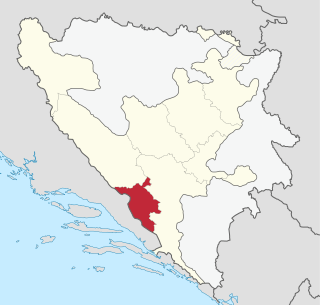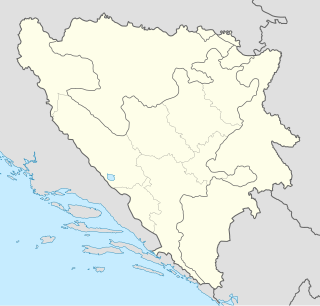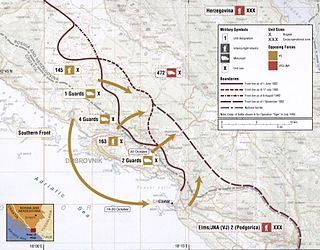
Bosnia and Herzegovina, abbreviated BiH or B&H, sometimes called Bosnia–Herzegovina and often known informally as Bosnia, is a country in South and Southeast Europe, located within the Balkans. Sarajevo is the capital and largest city.

The General Framework Agreement for Peace in Bosnia and Herzegovina, also known as the Dayton Agreement or the Dayton Accords, is the peace agreement reached at Wright-Patterson Air Force Base near Dayton, Ohio, United States, on 1 November 1995, and formally signed in Paris, on 14 December 1995. These accords put an end to the 3 1⁄2-year-long Bosnian War, one of the Yugoslav Wars.

The Federation of Bosnia and Herzegovina is one of the two political entities that compose Bosnia and Herzegovina, the other being Republika Srpska. The Federation of Bosnia and Herzegovina consists of 10 autonomous cantons with their own governments. It is sometimes known by the shorter name Federation of B&H.

Zachlumia or Zachumlia, also Hum, was a medieval principality located in the modern-day regions of Herzegovina and southern Dalmatia. In some periods it was a fully independent or semi-independent South Slavic principality. It maintained relations with various foreign and neighbouring powers and later was subjected to Kingdom of Hungary, Kingdom of Serbia, Kingdom of Bosnia, Duchy of Saint Sava and at the end to the Ottoman Empire.

Canton 10 is the largest of the cantons of the Federation of Bosnia and Herzegovina by area and eighth by population. It mainly covers an area of the historical and geographical region of Tropolje. The local government seat is in Livno, while the assembly is in Tomislavgrad.

Novo Sarajevo is a municipality of the city of Sarajevo, Bosnia and Herzegovina.

The West Herzegovina Canton is one of the cantons of the Federation of Bosnia and Herzegovina. In Croatian language, this canton is sometimes referred to as Županija Zapadnohercegovačka, but there is a significant difference between administrative units such as a županija compared to a canton, as defined in the Constitution of Bosnia and Herzegovina. The West Herzegovina Canton is in the Herzegovina region in the southwest of Bosnia and Herzegovina. Its seat of government is in Široki Brijeg, while other municipalities within the Canton are Grude, Ljubuški and Posušje. It has 94,898 inhabitants, of whom more than 98% are ethnic Croats.

Southeast Europe or Southeastern Europe (SEE) is a geographical region of Europe, consisting primarily of the coterminous Balkan Peninsula. There are overlapping and conflicting definitions as to where exactly Southeastern Europe begins or ends or how it relates to other regions of the continent. Sovereign states and territories that are included in the region are, in alphabetical order: Albania, Bosnia and Herzegovina, Bulgaria, Croatia, Greece, Kosovo, Montenegro, North Macedonia, Romania, Serbia, and East Thrace. Sometimes, Moldova and Slovenia are also included. The largest city of the region is Istanbul, followed by Bucharest, Sofia, Belgrade, and Athens.

The Eparchy of Zahumlje, Herzegovina and the Littoral is an eparchy (diocese) of the Serbian Orthodox Church with its seat in Mostar, Bosnia and Herzegovina. It has jurisdiction over the region of Herzegovina, the littoral region of southern Dalmatia in Croatia and a small part of Montenegro. Since 2018, the Bishop of Zahumlje and Herzegovina has been Dimitrije Rađenović.

Bosnia is the northern region of Bosnia and Herzegovina, encompassing roughly 81% of the country; the other region, the southern part, is Herzegovina.

Mate Boban was a Herzegovinian Croat politician and one of the founders of the Croatian Republic of Herzeg-Bosnia, an unrecognized entity within Bosnia and Herzegovina. Boban was the 1st President of Herzeg-Bosnia from 1991 until 1994. From 1992 to 1994 he was the President of Croatian Democratic Union of Bosnia and Herzegovina. He died in 1997.

This is the history of Bosnia and Herzegovina in the Middle Ages, between the ancient and Roman period and the Ottoman period.

Operation Neretva '93 was an Army of the Republic of Bosnia and Herzegovina (ARBiH) operation against the Croatian Defence Council (HVO) in September 1993 on a 200 km long front from Gornji Vakuf to south of Mostar, one of its largest of the year, on areas which were included in the Croatian Republic of Herzeg-Bosnia. The ARBiH did not achieve its objective to break through to southern Neretva valley and defeat the HVO in Herzegovina. During the operation dozens of Croat civilians were killed in the Grabovica and Uzdol massacres.

Herzegovina is the southern region of Bosnia and Herzegovina. It never had strictly defined geographical or cultural borders and it is not an administrative division in modern Bosnia and Herzegovina. It is generally taken to border larger Bosnia to the north, Dalmatia to the southwest and Montenegro to the southeast. Measurements of the area range widely from c. 11,500 km2 (4,400 sq mi), or around 23% of the total area of the present-day country, to c. 12,300 km2 (4,700 sq mi), around 25% of the country.

Bosnia and Herzegovina–Croatia relations are foreign relations between Bosnia and Herzegovina (BiH) and Croatia. Both countries established diplomatic relations on July 7, 1992. Bosnia and Herzegovina has an embassy in Zagreb, while Croatia has an embassy in Sarajevo and 6 consulates in Sarajevo, Banja Luka, Mostar, Tuzla, Livno and Vitez. The two countries share a 932-kilometer (579 mi) border.

The Siege of Mostar was fought during the Bosnian War first in 1992 and then again later in 1993 to 1994. Initially lasting between April 1992 and June 1992, it involved the Croatian Defence Council (HVO) and the Army of the Republic of Bosnia and Herzegovina (ARBiH) fighting against the Serb-dominated Yugoslav People's Army (JNA) after Bosnia and Herzegovina declared its independence from Yugoslavia. That phase ended in June 1992 after the success of Operation Jackal, launched by the Croatian Army (HV) and HVO. As a result of the first siege around 90,000 residents of Mostar fled and numerous religious buildings, cultural institutions, and bridges were damaged or destroyed.

Operation Jackal, also known as Operation June Dawns, was an offensive of the Bosnian War fought between a combined Croatian Army (HV) and Croatian Defence Council (HVO) army against the Army of Republika Srpska (VRS) from 7–26 June 1992. The offensive was a Croatian pre-emptive strike against the VRS, a Bosnian Serb military formed in May 1992 from Yugoslav People's Army (JNA) units that were stationed in Bosnia and Herzegovina. The HV concluded that the JNA offensive operations of April and May 1992, resulting in the capture of Kupres and much of the Neretva River valley south of Mostar, were aimed at capturing or threatening the Croatian Port of Ploče and possibly Split. To counter this threat, the Croatian leadership deployed the HV, under the command of General Janko Bobetko, to the "Southern Front" including the area in which Operation Jackal was to be conducted.

Operation Tiger was a Croatian Army (HV) offensive conducted in areas of Croatia and Bosnia and Herzegovina near Dubrovnik between 1 and 13 July 1992. It was designed to push the Army of Republika Srpska (VRS) away from the city towards Popovo field and secure a supply route via Rijeka Dubrovačka, which was gained in early June as the Siege of Dubrovnik by the Yugoslav People's Army (JNA) was lifted. The operation's success was facilitated by the establishment of the HV's Southern Front command and the successful conclusion of the May–June 1992 operations against the VRS in the Neretva River valley, which concluded with Operation Jackal.

Operation Southern Move was the final Croatian Army (HV) and Croatian Defence Council (HVO) offensive of the Bosnian War. It took place in western Bosnia and Herzegovina on 8–11 October 1995. Its goal was to help the Army of the Republic of Bosnia and Herzegovina (ARBiH) whose positions around the town of Ključ, captured by them during Operation Sana, were endangered by a counteroffensive by the Army of Republika Srpska (VRS). The objectives of Operation Southern Move included the capture of the town of Mrkonjić Grad and positions on the Manjača Mountain which would allow the HV and the HVO to directly threaten Banja Luka, the largest city controlled by Bosnian Serbs. Finally, the offensive was also aimed at capturing the Bočac Hydroelectric Power Station, the last significant source of electricity under VRS control in western Bosnia and Herzegovina. The combined HV and HVO forces were under the overall command of HV Major General Ante Gotovina.

















